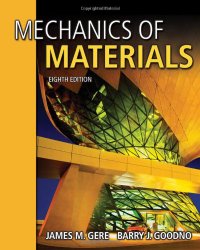Engineering Bookshelf
- Aerospace
- Biological
- Civil
- Chemical
- Environmental
- Electrical
- Materials
- Mechanical
- Petroleum
- Geoengineering
- Software

Mechanics of Materials
by James M. Gere, Barry J. GoodnoPublisher: Cengage Learning
ISBN: 1111577730
Check price @ amazon.com , amazon.ca , amazon.co.uk
Book Description
The Eighth Edition of MECHANICS OF MATERIALS continues its tradition as one of the leading texts on the market. With its hallmark clarity and accuracy, this text develops student understanding along with analytical and problem-solving skills. The main topics include analysis and design of structural members subjected to tension, compression, torsion, bending, and more. The book includes more material than can be taught in a single course giving instructors the opportunity to select the topics they wish to cover while leaving any remaining material as a valuable student reference.
Book Reviews
"The authors do and excellent job of discussing the topics at a level I believe will be absorbed by the students. They also make a good effort to highlight the important issues and points in the text by italicizing or bolding. I feel that the author has done an excellent job of relating real structures to solid body analysis techniques, and haspresented and discussed it in a manner that I think students will appreciate."
"The homework problems are perhaps the strongest point of the text. The problems cover the waterfront in variety, complexity and coverage. They include numerous examples that are found inthe real world and students can identify with them."
"The books strongest feature is the comprehensive coverage and reasonableness of the homework problems in establishing a base of understanding of expected levels of stress, strain, and displacement."
"The author has done an excellent job conveying the concepts. The textbook is easy to follow and all the ideas are clearly presented."
"This is a detailed overview of undergraduate solid mechanics. It is an excellent book, and far superior to current texts, which borrowed extensively from Gere."
About the Author
James M. Gere (1925-2008) earned his undergraduate and master's degree in Civil Engineering from the Rensselaer Polytechnic Institute in 1949 and 1951, respectively. He worked as an instructor and later as a Research Associate for Rensselaer. He was awarded one of the first NSF Fellowships, and chose to study at Stanford. He received his Ph.D. in 1954 and was offered a faculty position in Civil Engineering, beginning a 34-year career of engaging his students in challenging topics in mechanics, and structural and earthquake engineering. He authored nine texts on various engineering subjects starting in 1972 with Mechanics of Materials. He served as Department Chair and Associate Dean of Engineering and in 1974 co-founded the John A. Blume Earthquake Engineering Center at Stanford. In 1980, Jim Gere also became the founding head of the Stanford Committee on Earthquake Preparedness. That same year, he was invited as one of the first foreigners to study the earthquake-devastated city of Tangshan, China. Jim retired from Stanford in 1988 but continued to be an active and most valuable member of the Stanford community.
Dr. Barry J. Goodno is a Fellow of the American Society of Civil Engineers and a member of the Structural Engineering (SEI) and Engineering Mechanics (EMI) Institutes of ASCE. He is a Past-President of the SEI Board of Governors. He teaches graduate courses at Georgia Institute of Technology in structural dynamics and matrix structural analysis, as well as undergraduate courses at Georgia Tech in statics and dynamics and mechanics of materials. He conducts research and has published extensively in the areas of earthquake engineering, structural dynamics, matrix structural analysis, hybrid control of structures, influence of nonstructural systems on building response, base isolation, vibrations, and finite element analysis. Dr. Goodno received his Ph.D. from Stanford University and is a registered Professional Engineer in Georgia.
Customer Reviews
By TonyR
This book makes an already difficult course harder. I found this book frustrating. The chapters are pretty long yet don't explain much. You'll get a few formulas and an example or two only to find out they are pretty much useless to solve the end of chapter problems. The problems can be so complicated to solve that without the actual book solution you probably wouldn't even think to solve the problem that way. Newer editions of this book just change a few problems around (to make the old solution manual useless) so it's pretty much the same as previous versions.
This is still an OK book to learn the subject, but just prepare yourself to put a lot of effort and hours to get things right. I would recommend this book if you are able to work out the problems with your professor or T/A as they have the solutions and will help you understand better.
By Shannen
can't say I loved the course, but this is a good text book. :) Examples are the same style as Statics and Dynamics, so that's a little extra consistency.
I'm keeping it to study for the FE later.